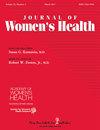人类乳头瘤病毒初级筛查:妇女对宫颈癌筛查新建议的看法。
IF 3
3区 医学
Q1 MEDICINE, GENERAL & INTERNAL
引用次数: 0
摘要
背景:目前的临床指南推荐在宫颈癌检测中进行人类乳头瘤病毒(HPV)初筛。先前的研究报告了患者层面的障碍(如对巴氏试验的有限了解和依恋),这些障碍可能会阻碍 HPV 初筛的广泛采用。我们在南加州凯撒医疗集团(KPSC)实施 HPV 初筛(2020 年 7 月)后对这些妇女层面的因素进行了评估。方法:我们对 2020 年 10 月至 12 月期间接受 HPV 初筛的 30-65 岁 KPSC 女性会员进行了患者调查(邮寄和在线)。对选择英语和西班牙语的患者分别进行了抽样调查。调查内容包括对 HPV 和 HPV 筛查的了解、对筛查指南的认识以及对 HPV 检测的态度。人口统计学数据通过电子健康记录收集。我们使用加权多变量逻辑回归和修正泊松回归分析了语言偏好与调查回答之间的关联。结果:共收回 3,009 份调查问卷(回复率为 38.0%)。很少有妇女(7.0%)认为 HPV 检测是一种可接受的筛查方法。大多数妇女(92.2%)仍不知道人乳头瘤病毒检测可以取代巴氏试验进行筛查。33.2%的讲西班牙语的妇女(19.9%的讲英语的妇女)最喜欢的筛查方法是子宫颈抹片检查。只有 20.6% 的人知道 30-65 岁的妇女可以每 5 年进行一次联检或 HPV 初筛。大多数妇女(96.4%)不认为接受 HPV 检测是一种耻辱。结论积极主动的患者教育将有助于提高妇女对 HPV 初筛的认识,从而促进其在更多医疗机构的实施。本文章由计算机程序翻译,如有差异,请以英文原文为准。
Primary Human Papillomavirus Screening: Women's Perceptions of New Cervical Cancer Screening Recommendations.
Background: Current clinical guidelines recommended primary human papillomavirus (HPV) screening for cervical cancer testing. Previous studies reported patient-level barriers (e.g., limited knowledge and attachment to Pap test) that may hinder wide adoption of primary HPV screening. We assessed these women-level factors following the implementation of primary HPV screening (July 2020) at Kaiser Permanente Southern California (KPSC). Methods: We administered a patient survey (mail and on-line) to female KPSC members aged 30-65 years who received primary HPV screening between October and December 2020. Those who preferred English vs. Spanish language were sampled separately. The survey included domains on knowledge about HPV and HPV screening, awareness of screening guidelines, and attitudes about HPV testing. Demographic data were collected using electronic health records. We used weighted multivariable logistic and modified Poisson regressions for associations between language preference and survey responses. Results: In total, 3,009 surveys were returned (38.0% response rate). Few women (7.0%) found HPV testing as an acceptable screening method. The majority of women (92.2%) remained unaware that HPV testing can replace Pap test for screening. The Pap test was the most preferred screening approach for 33.2% Spanish-speaking women vs. 19.9% English-speaking women. Only 20.6% knew that women aged 30-65 years can be screened every 5 years with cotest or primary HPV screening. Most women (96.4%) did not perceive stigma about taking the HPV test. Conclusion: Proactive patient education will help improve women's knowledge about primary HPV screening, which may facilitate its implementation in additional health care settings.
求助全文
通过发布文献求助,成功后即可免费获取论文全文。
去求助
来源期刊

Journal of women's health
医学-妇产科学
CiteScore
6.60
自引率
5.70%
发文量
197
审稿时长
2 months
期刊介绍:
Journal of Women''s Health is the primary source of information for meeting the challenges of providing optimal health care for women throughout their lifespan. The Journal delivers cutting-edge advancements in diagnostic procedures, therapeutic protocols for the management of diseases, and innovative research in gender-based biology that impacts patient care and treatment.
Journal of Women’s Health coverage includes:
-Internal Medicine
Endocrinology-
Cardiology-
Oncology-
Obstetrics/Gynecology-
Urogynecology-
Psychiatry-
Neurology-
Nutrition-
Sex-Based Biology-
Complementary Medicine-
Sports Medicine-
Surgery-
Medical Education-
Public Policy.
 求助内容:
求助内容: 应助结果提醒方式:
应助结果提醒方式:


